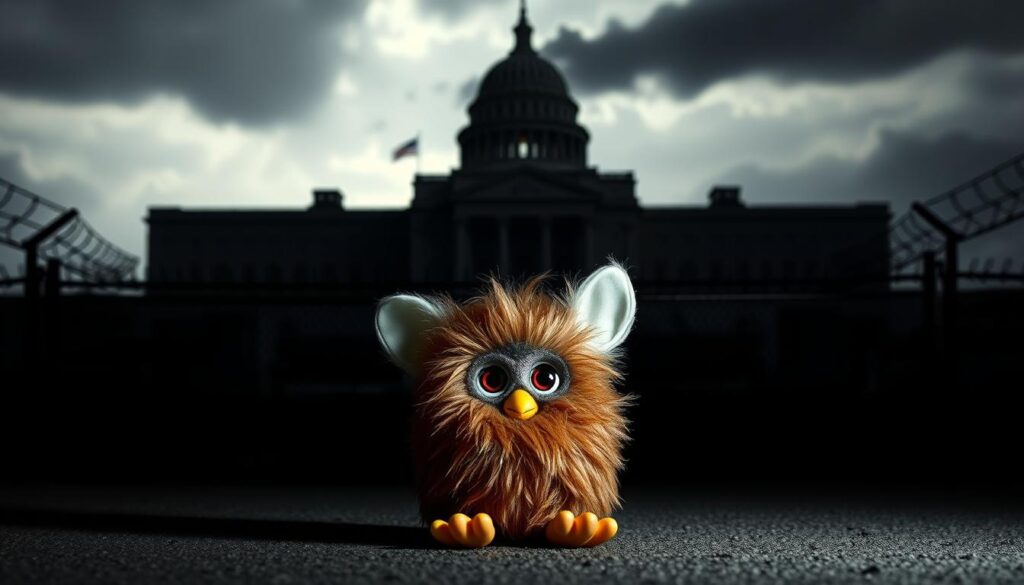The Furby, an electronic robotic toy by Tiger Electronics, took the world by storm in 1998. With its ability to interact and speak in 14 languages, it became a must-have during the holiday season, selling over 40 million units in just three years.
As its popularity soared, concerns arose, leading to unexpected restrictions in government facilities. We’ll explore the story behind these events and examine how a children’s toy became a potential security threat. For more insights into the psychology behind the fear surrounding Furby, visit our article on the creepy Furby. Understanding the timeline of these events provides interesting insights into both toy popularity and security concerns at the turn of the millennium.
To clarify the facts surrounding the Furby bans, we’ll separate fact from fiction and provide accurate information on this fascinating topic. If you’re still curious about how to handle your Furby, check out our guide on how to turn off Furby.
The Rise of Furby: A 90s Phenomenon
Furby’s debut in 1998 was more than just a new toy release; it was the beginning of a cultural phenomenon that would peak during the holiday season. As we explore the rise of Furby, it’s essential to understand what made this toy so captivating and how it became a staple of 90s pop culture.
What Was a Furby?
A Furby was an electronic, furry creature that could interact with its owner through a series of beeps, movements, and changes in its facial expressions. It was designed to learn and adapt, creating a unique bond with each child who owned one. The initial retail price of a Furby was around $35, but as demand skyrocketed, so did the price on the secondary market.
The Furby Craze of 1998
The holiday season of 1998 saw an unprecedented demand for Furbies, catapulting them into a cultural phenomenon. The demand was so high that it drove the resale price over $100, and sometimes as high as several hundred dollars. Furbies were sold for over $300 in newspapers and at auctions. The different aesthetic varieties were given nicknames, and sellers assigned rarity values to them, turning Furbies into collectibles almost overnight.
Some key aspects of the Furby craze include:
- The explosive demand during the 1998 Christmas period, which created a secondary market with significantly inflated prices.
- The assignment of nicknames and rarity values to different Furby varieties, making them highly sought after by collectors.
- The unfortunate instances of fraud, where customers paid for Furbies that were never delivered, highlighting the chaotic nature of the secondary market.
As we examine the Furby phenomenon, it becomes clear that its impact was not just about the toy itself, but about the cultural and social dynamics it triggered during that time. The popularity of Furby was a defining characteristic of the 1998 holiday season, and its influence can still be seen in how we perceive and interact with interactive toys today. For more insights into the darker side of Furby’s history, you can read about the cursed Furbies and explore the question of whether Furbies are haunted.
When Were Furbies Banned by the NSA?
A sudden ban by the NSA in January 1999 left many wondering about the security implications of having Furbies around. The decision to prohibit these popular electronic toys from NSA premises was not taken lightly and was rooted in specific security concerns. To understand the reasoning behind this ban, it’s essential to examine the events and fears surrounding Furbies at the time.
The January 1999 NSA Ban
In January 1999, the NSA issued a ban on Furbies, classifying them alongside other prohibited recording devices. This move was largely unexpected, given Furbies were marketed as harmless, interactive toys. The ban was a response to concerns that Furbies might pose a risk to national security due to their perceived ability to record and potentially repeat sensitive information.
As stated by the NSA, “Personally owned photographic, video and audio recording equipment are prohibited items. This includes toys, such as Furbies, with built-in recorders that repeat the audio with synthesized sound to mimic the original signal.” This statement underscores the agency’s primary concern: the potential for Furbies to capture and replay confidential information discussed in secure environments.
| Reason for Ban | Description |
|---|---|
| Recording Capability | Fear that Furbies could record and repeat sensitive information |
| Artificial Intelligence | Concerns that Furbies could “learn” and potentially repeat confidential information |
| National Security | Perceived threat to national security due to potential information leakage |
Security Concerns Behind the Ban
The NSA’s decision to ban Furbies was primarily driven by concerns over the toy’s potential recording capabilities and its perceived artificial intelligence. It was believed that Furbies contained a chip that allowed them to “learn” from users, potentially capturing and repeating sensitive information discussed in secure facilities. For more insights into the Furby ban and its implications, visit Why Were Furbies Banned: Facts and.
The Furby’s ability to seemingly learn language over time contributed to the misconception that it could record and repeat specific information. This misconception, coupled with the toy’s built-in recording capabilities, led the NSA to take precautionary measures to protect national security and prevent potential information leaks.

The ban on Furbies by the NSA reflects broader concerns about emerging technologies and their potential impact on information security in sensitive government facilities. It highlights the challenges faced by security agencies in assessing new technologies and mitigating potential risks to national security.
Beyond the NSA: Other Furby Bans and Restrictions
The Furby phenomenon raised security concerns that resonated across multiple government agencies and facilities. As the toy’s popularity soared in the late 1990s, various organizations began to take notice of its potential security risks.
FAA and Airline Concerns
The Federal Aviation Administration (FAA) and airlines also had concerns regarding Furbies on flights. According to an FAA document, there were worries about the potential for Furbies to interfere with aircraft systems or pose a security risk due to their ability to record and repeat sounds. While there isn’t evidence of a blanket ban by the FAA, some airlines and flight crews may have advised against bringing Furbies on board due to these concerns.
Military and Government Facility Restrictions
Military installations and government facilities took a more stringent approach to Furbies. The toy was banned from the Naval Shipyard in Portsmouth, VA, and there were similar restrictions at other naval and military bases. The primary concern was the potential for Furbies to act as recording devices, given their advanced sensors and moving ears. Some facilities required the removal of batteries from any Furbies brought near sensitive equipment to mitigate potential risks.
Government facilities were particularly concerned about the sensors in Furbies and their potential to capture sensitive information. As a result, various military installations prohibited the toy from their premises, citing security concerns similar to those raised by the NSA. The restrictions on Furbies reflected broader security protocols regarding electronic devices in sensitive environments.
The Truth About Furby’s Capabilities
As we explore the truth about Furby, it becomes clear that its capabilities were greatly exaggerated. The Furby was a robot toy that captured the hearts of many in the 90s, but it was also surrounded by controversy and misinformation.
Roger Shiffman, the owner of Tiger Electronics, publicly stated that “Furby has absolutely no ability to do any recording whatsoever,” attempting to dispel the spy rumors. This statement was supported by Dave Hampton, the creator of Furby, who demonstrated that the toy’s sensors could only detect general sounds, not record specific language or information.
The illusion of “learning” came from a pre-programmed English vocabulary that was gradually revealed over time as people interacted with the toy. According to the toy’s patent, Furby was not actually “learning” new information, but rather unveiling its pre-programmed capabilities.
The microprocessor chip in Furbies was designed to create a simulated learning experience through its furry exterior, but lacked any actual recording technology. The NSA eventually withdrew their ban after understanding the actual technical limitations of the toy, though this received far less publicity than the initial restrictions.
For more information on the original release date of Furby and its rise to fame, you can visit our article on when Furby was first introduced.
In conclusion, the Furby was a fascinating toy that captured the imagination of many, but its capabilities were often misunderstood. By understanding the truth about Furby’s limitations, we can appreciate the innovation and creativity that went into creating this beloved robot toy.


